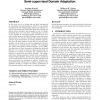130 search results - page 25 / 26 » I-TASSER server for protein 3D structure prediction |
BMCBI
2008
13 years 7 months ago
2008
Background: The study of protein-protein interactions is becoming increasingly important for biotechnological and therapeutic reasons. We can define two major areas therein: the s...
CONSTRAINTS
2008
13 years 7 months ago
2008
Bioinformatics aims at applying computer science methods to the wealth of data collected in a variety of experiments in life sciences (e.g. cell and molecular biology, biochemistry...
BMCBI
2005
13 years 7 months ago
2005
Background: In a previous report (La et al., Proteins, 2005), we have demonstrated that the identification of phylogenetic motifs, protein sequence fragments conserving the overal...
CIKM
2008
Springer
13 years 9 months ago
2008
Springer
In this work we try to bridge the gap often encountered by researchers who find themselves with few or no labeled examples from their desired target domain, yet still have access ...
BMCBI
2008
13 years 7 months ago
2008
Background: A multiple sequence alignment (MSA) generated for a protein can be used to characterise residues by means of a statistical analysis of single columns. In addition to t...

